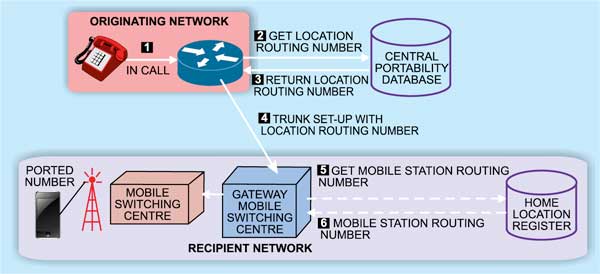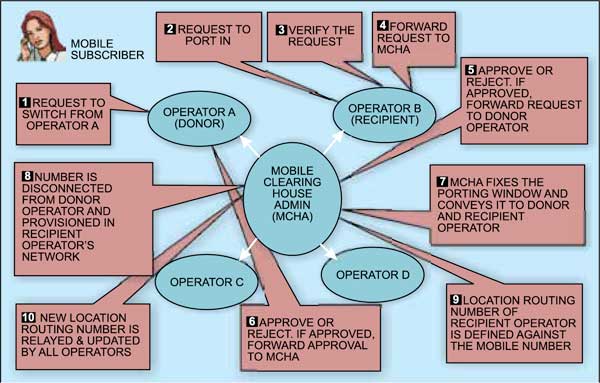Relay using location routing number. In this scheme, a location routing number is used to route the call to the correct terminating network. The call flow is shown in Fig. 3. Again, in this method of number portability, all the network elements of originating, donor and recipient networks are kept busy for the entire duration of call. Further, this approach is susceptible to establishing a tromboning call set-up when the originating network is also a recipient network (Fig. 4).
Basically, tromboning is where a call originates at a certain point, and follows a path out into the network and back to a destination close to where the call originated. In this way, several networks and their entities are kept busy unnecessarily. So this mobile number portability scheme is not recommended.
All-call-query approach. This is a direct routing scheme that utilises a centralised ported database. In this scheme, the originating network directly queries the central ported database to determine the routing number required to transfer the call to the recipient operator. After determining the routing number, the call from the originating network is directly routed to the recipient operator network. In this way, the involvement of donor operator is eliminated.


In this approach, the originating network directly queries a central portability database to get the location routing number in order to route the call to the gateway mobile switching centre of the correct terminating network. Further, the gateway mobile switching centre sets up trunk to the serving mobile switching centre to establish the call (Fig. 5).
The donor network does not take part in the call process and utilises network resources most efficiently to route a call. Thus this scheme is considered to be the most efficient routing scheme for large interconnected networks and a large number of ported numbers.
MNP in India
On March 8, 2006, the Telecom Regularity Authority of India (TRAI) issued draft regulations to facilitate mobile number portability in India and submitted its recommendations to the Department of Telecommunication (DoT). Finally, the DoT recommended service provider number portability including service portability (portability between GSM and CDMA) for all mobile service operators. It was decided to implement the all-call-query approach for mobile number portability.
The DoT has divided the whole country into two zones for MNP—north-west zone and south-east zone—and awarded licences to two vendors to work as MNP clearing house administrators. The north-west zone comprises Gujarat, Haryana, Himachal Pradesh, Jammu and Kashmir, Maharashtra, Punjab, Rajasthan, UP (East), UP (West), Delhi and Mumbai. The south-east zone comprises Andhra Pradesh, Bihar, Assam, Karnataka, Kerala, Madhya Pradesh, North East, Orissa, Tamil Nadu, West Bengal and Kolkata.
MNP clearing house administrators manage a central mobile number portability database that keeps record of all ported-in and ported-out numbers. Further, the operators also maintain their own MNP database called local number portability database.











This was a great article.
However I have unique problem.
I have been trying to port my BSNL number to Jio. But whenever jio puts in a port request they get an error ‘incorrect donor’. When BSNL asked, they say that there is no problem from their end.
I have had this number for more than a year and it’s a prepaid. And I have now tried to port twice. Both times the same problem.
Could you tell me what’s the problem and the solution.
An useful and esay to understand Thanks
Thank You for your feedback.